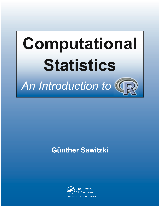
In its basic version, R contains more than 1500 functions - too many to introduce in just one course, and too many to learn reasonably. The course can only open the way to R.
Course participants can come from various background, with different prerequisites. For pupils and younger students, a mere programming course on technical basics may be appropriate. Later in study, questions about meaningful classification and background will be more important. This is what the present course aims at. The "technical" material gives a skeleton. Beyond this, we try to open the view for statistical questions and to stimulate interest for the background. The course should sharpen the appetite for the substance which may be offered in a subsequent well-founded statistical course.
The first part of this course material is organised by themes, using example topics to illustrate how R can be used to tackle statistical problems.
An appendix gives a collection of R language elements and functions. During the course, it can help as a quick reference and it may serve as a starting point and orientation to access the rich information material which comes bundled with R. After the course, it may serve as a note pad. Finally, on the long run for practical work, the online help and online manuals of R are the prime sources of information. This appendix is not meant to be comprehensive. If a concise syntax description or example could be given, it its included. In other cases, the online help information should be consulted.
Using a selection of the exercises, the course can be completed within about four days of work. Conceptually, it is an introduction to statistics with the topic areas
A generous time slot for exercises is recommended (an additional half day for the introductory exercises, an additional half day for one of the project exercises). With this, the course can be covered in one week, provided follow up facilities are established to answer questions which have come up, and possibilities are available to follow the interest in statistical background which may have resulted.
At a more leisurely pace, chapter 1 with its exercises can be used on its own. This should give a working base to use R, and more material from the subsequent chapters can be added later when it is needed. The first chapter is fairly self-contained, including the necessary basic definitions of statistical terms. The other chapters assumes that the reader can look them up if necessary.
Using the course during a term in a weekly class needs more time, since repetitions must be calculated in. Each of the first four chapters will cover about four lectures, plus time for exercises. For this time schedule, a course to cover the statistical background is recommended running in parallel.
For a subsequent self-paced study going into details on R as a programming language, the recommended reading is (William N. Venables and Brian D. Ripley: S Programming, Springer 2000).
Statistical literature is evolving, and new publications will be available at the time you read this text.
Instead of giving a long list of the relevant literature available at the time this text is written,
the sections include keywords which can be used to locate up to date literature.
For economic reasons, part of the illustrations are printed in black and white. Colour versions are available at the web site
accompanying this book:
![]()
![]()
![]()
Up: Introduction
Previous: What is R?
Contents
gs
2008-08-23